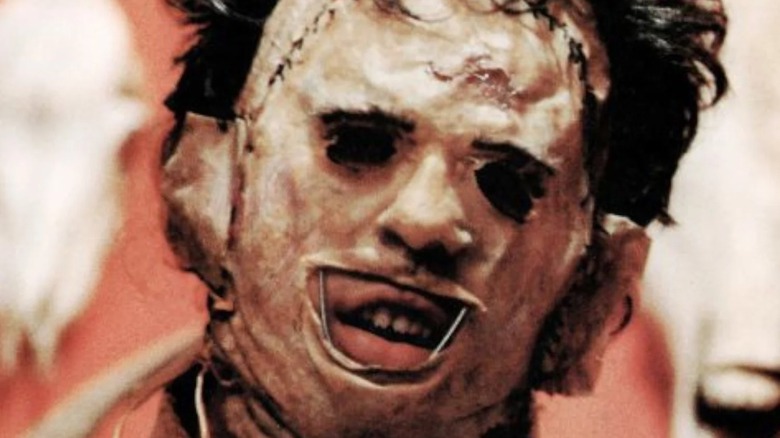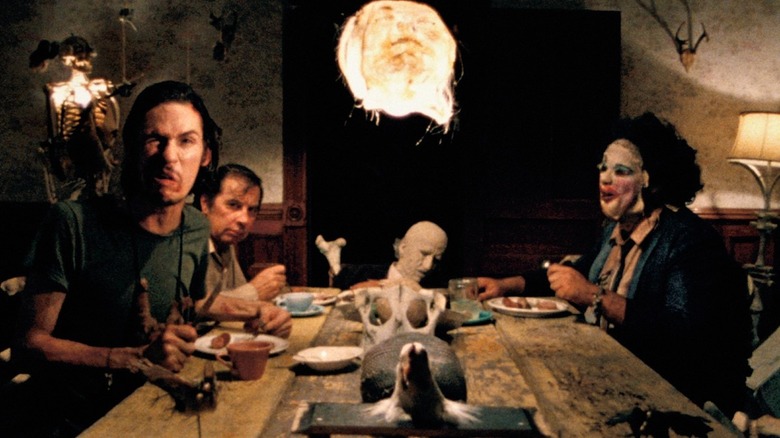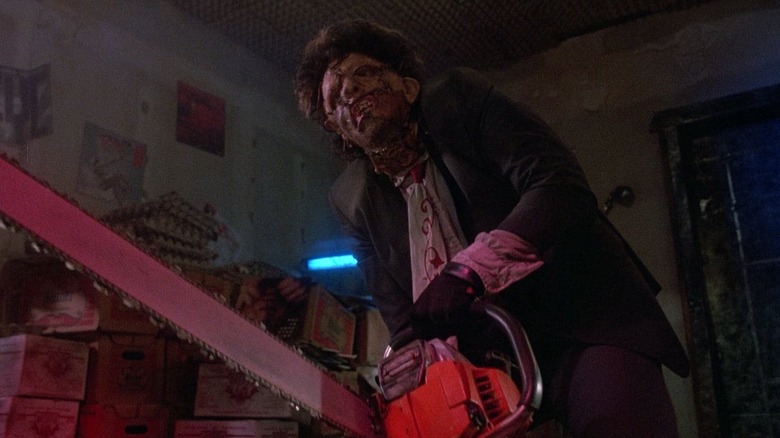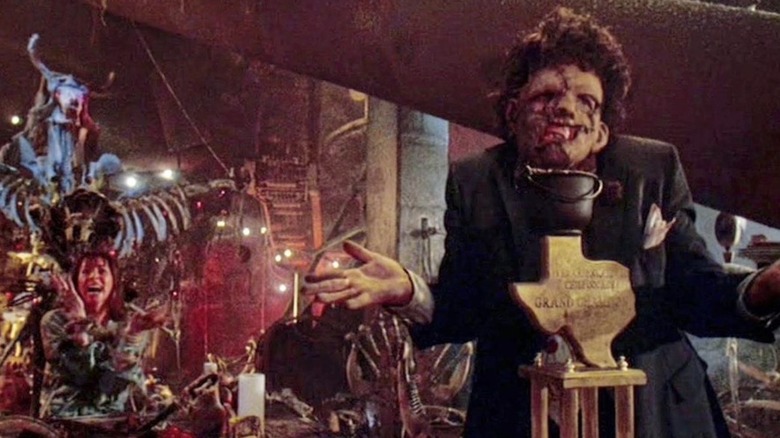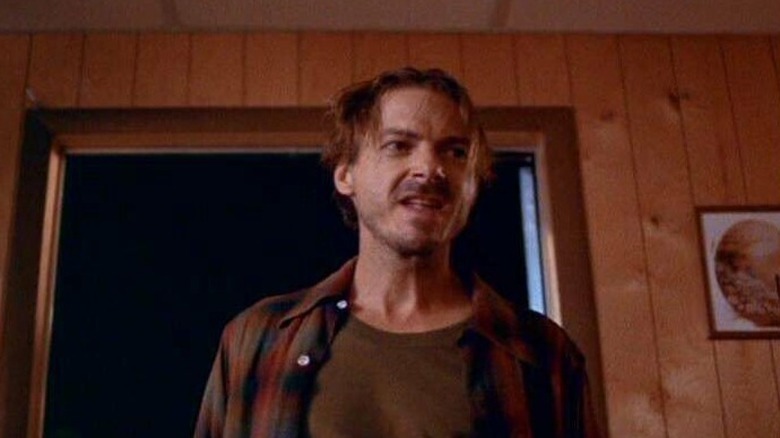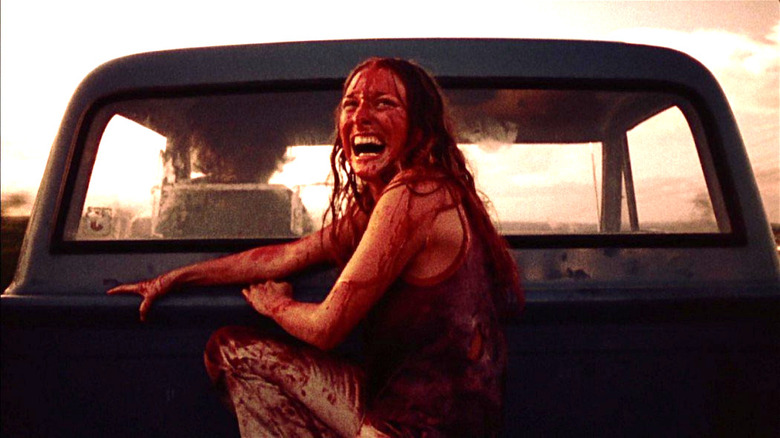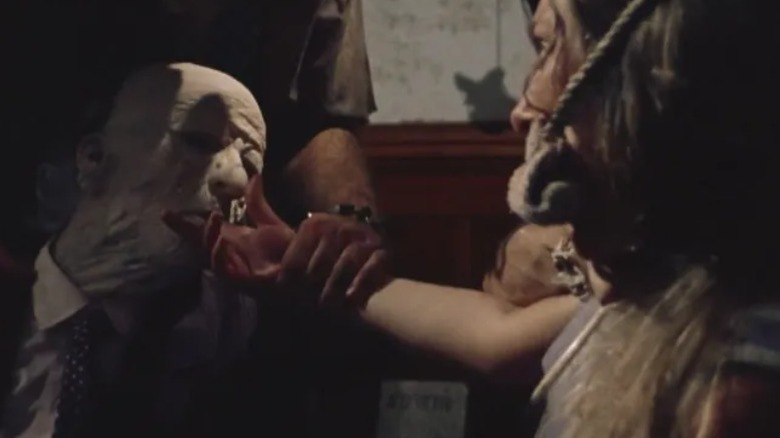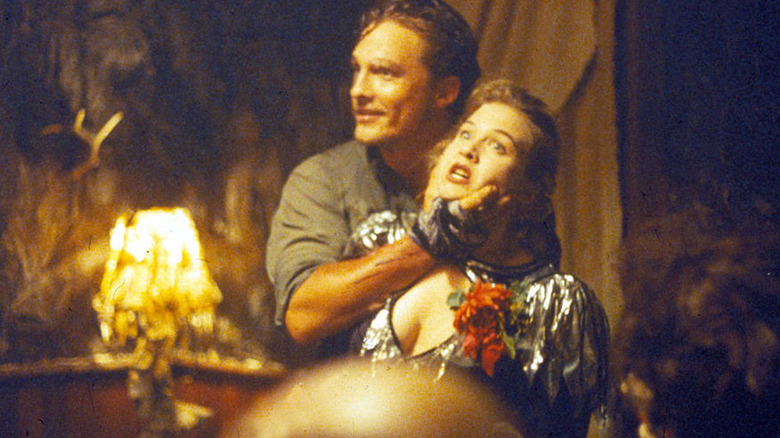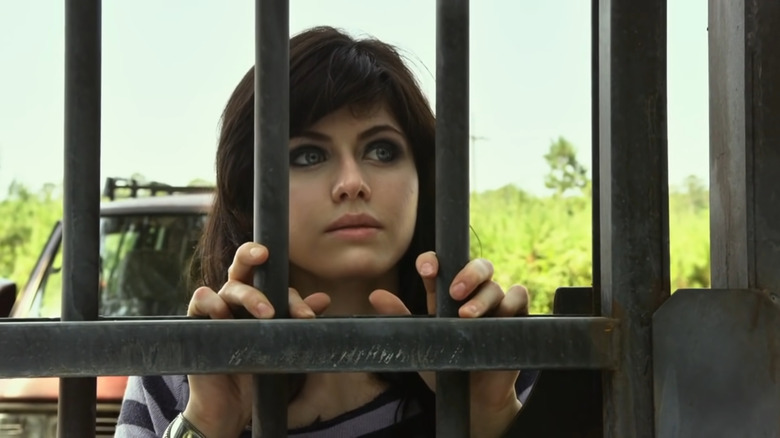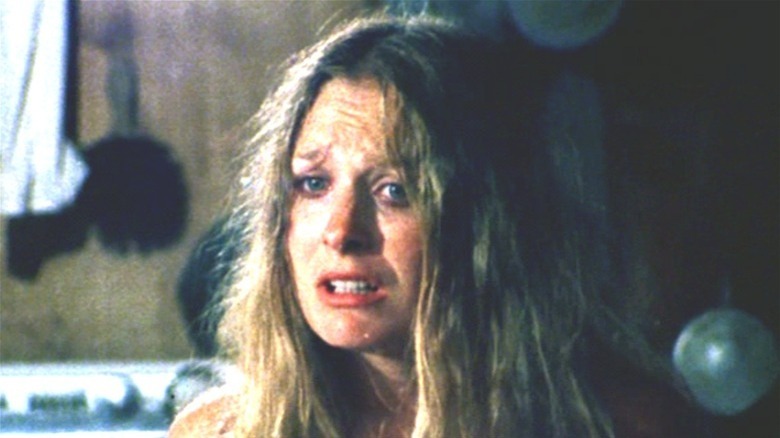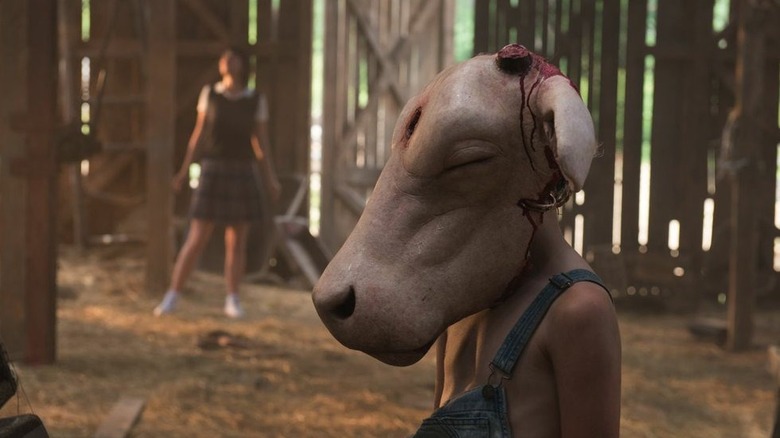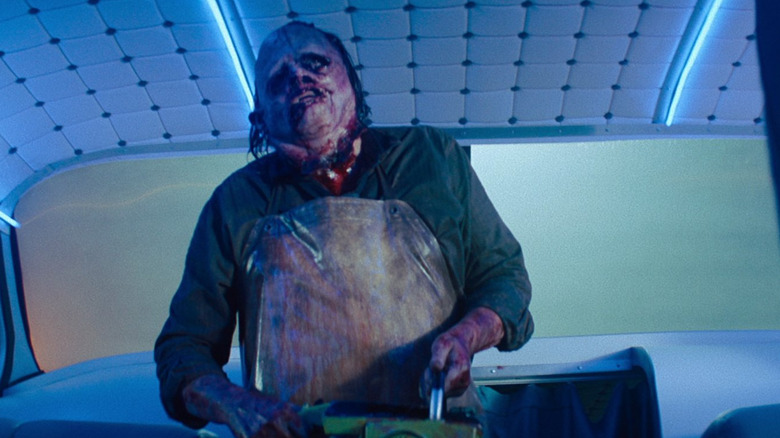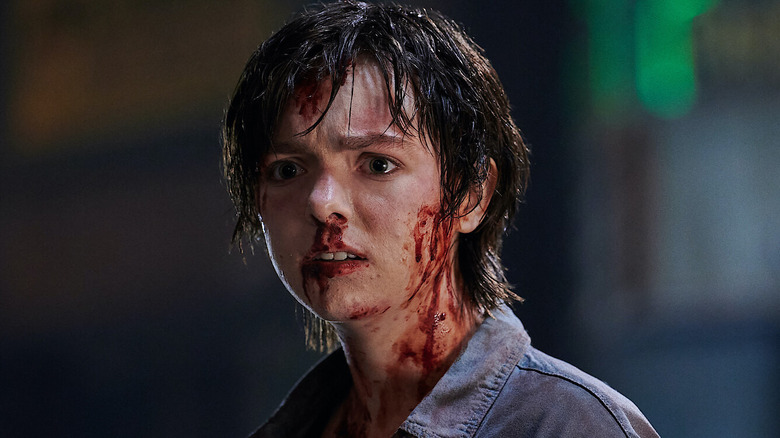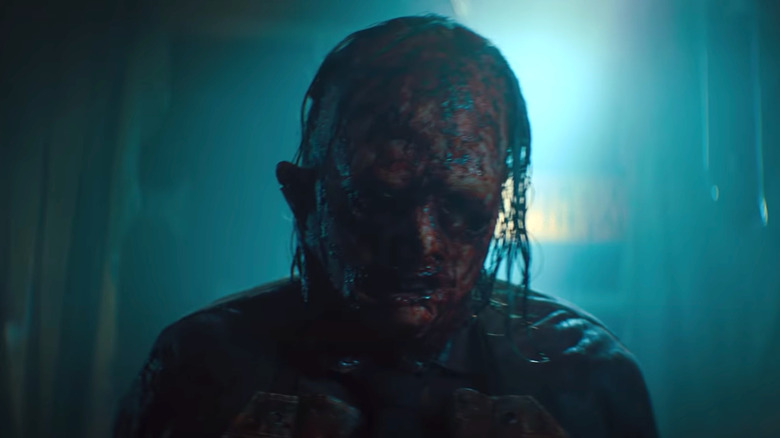Questionable Things We Ignore In The Texas Chainsaw Massacre Franchise
In 1974, filmmaker Tobe Hooper unleashed "The Texas Chain Saw Massacre," a slasher film about a cannibalistic family living in central Texas. At the time, no other horror movie had told a story so vividly, so unsparing, brutal and raw. It became a singular sensation, and has since become renowned for helping usher in a golden age of slashers. Films from "Halloween" to "X" (and countless other blood-splatterers) have since tried capturing the same visceral horror, but few have succeeded.
In the near-half-century that has passed since Hooper made his opus, the franchise (which now sits at nine installments) has made choices that have sometimes upended the established lore of the original. Some of Hollywood's biggest stars — from Matthew McConaughey to Renee Zellweger to Jessica Biel — have taken part in these sequels, often as launching points for a career beyond the carnage.
Many of these films have registered low critical favor, but The "Texas Chain Saw Massacre" fanbase remains strong, still hopeful that next great scare is just around the corner. Below is a breakdown of "Chainsaw" touchstones, and why as the years have gone by they have become nearly as twisted as the Sawyers/Hewitts themselves.
The Sawyer family name change
The "Texas Chainsaw Massacre" franchise would not be as popular as it is without the Sawyer family, a tight-knit group of cannibals and murderers. When viewers first met the Sawyers in "The Texas Chainsaw Massacre" in 1974, there was Drayton (Jim Siedow), who owns a gas station in Williamson County, his hitchhiking brother Nubbins (Edwin Neal) and chainsaw-wielding butcher "Leatherface" (Gunnar Hansen). Along with the brothers is "Grandfather" (John Dugan), who lives in the attic of the Sawyer house. Collectively, they are psychopathic cannibals living in the boonies of central Texas.
In the 2003 remake, the Sawyers are discarded for a new batch of antagonists: The Hewitt family. Composed of Luda May (Marietta Marich), Jedediah (David Dorfman), Sheriff Hoyt (R. Lee Ermey), The Tea Lady (Kathy Lamkin), Monty (Terrence Evans), and Leatherface (Andrew Bryniarski).
What made the Sawyer Family so terrifying 50 years ago was how Tobe Hooper made them out to be normal Texans with a secret life in the dark undercurrent of culture. The Hewitts, however, are portrayed to be much more ruthless and far less hidden in plain sight. The name change only exists in the remake series, accompanying Marcus Nispel's grimier take on Hooper's opus. After the franchise was dormant for seven years, the Sawyers would return again in 2013's "Texas Chainsaw 3D."
The phallecy of Leatherface's chainsaw
Though Hooper only spent around $100,000 making the first film, it went on to gross over $30-million worldwide and, much like the franchise's contemporaries "Halloween" and "Friday the 13th," should have spawned a plethora of sequels. That wasn't the case, though, as the franchise was idle for 12 years. When Hooper finally returned in 1986 with "The Texas Chainsaw Massacre 2," he did so with a film comprised of a vastly different tone, one willing to poke fun at itself.
"The Texas Chainsaw Massacre 2" is much campier, embracing black comedy in similar ways to '80s genre classics like "Army of Darkness" and "Re-Animator." Jim Siedow returns as Drayton Sawyer, while Nubbins is replaced by Chop-Top (Bill Moseley), a Vietnam veteran cannibal obsessed with music. Leatherface (Bill Johnson) is back, of course, even if his character is much more over-the-top. Hooper even attempts to give Leatherface complexity via a quasi-love story, depicting his romantic feelings toward Stretch (Caroline Williams).
In the irreverent sequel, there is also a strong implication that Leatherface can't achieve sexual gratification without his chainsaw. The way he frequently holds the weapon near his groin when he isn't going berserk with it, apparently, seems to be alluding to impotence issues. That subtext is only solidified when his frustrations toward Stretch send him into a chainsaw-wielding rage. In later films, Leatherface is portrayed as a broken person abandoned by his original family. Here, Hooper tries to explore what makes Leatherface kill — and it's a ruthlessness grounded in phallic inadequacies.
Leatherface's death
It's not uncommon for horror movies to retcon the endings to their own sequels. In "Halloween 4," for instance, Michael Myers' supposed death in "Halloween 2" was ignored; in "Friday the 13th: Part 2," Jason Voorhees, who supposedly drowned as a child, was once again alive and well as an adult. The "Texas Chainsaw Massacre" franchise isn't immune to such twists of logic, either, as Leatherface died on-screen once, yet still remains the face of the franchise.
In "The Texas Chainsaw Massacre 2," Leatherface meets his demise at the film's end. After Lt. Boude "Lefty" Enright (Dennis Hopper) defeats the Sawyers, Drayton accepts defeat by blowing up himself, Lefty, Leatherface, and Grandpa (Ken Evert) atop the abandoned carnival grounds that the family calls home. Not to mention that, before Drayton killed his entire family with a grenade, Leatherface took a fatal blow to the stomach from Lefty's chainsaw.
When Jeff Burr took over the franchise in 1990, directing "Leatherface: The Texas Chainsaw Massacre III," he reversed Hooper's finality by taking the Sawyers back to middle-of-nowhere Texas, re-setting in an effort to rehash what happened in the first film 16 years prior. Suddenly, Leatherface was back, once again wielding his chainsaw and killing naive travelers. It's like he never left — even though we all saw him go.
Who is W.E. Sawyer?
W.E. Sawyer (Joe Stevens) is a real character in "Texas Chainsaw Massacre: The Next Generation." In fact, he's Leatherface's brother. What does he do in the movie? Well, he threatens other characters at gunpoint alongside Leatherface (Robert Jacks), then gets knocked unconscious by his own brother Vilmer (Matthew McConaughey).
The character's real name is Walter Edward, but his nickname W.E. was coined by Vilmer and his wife Darla (Tonie Perensky). He's the "high-cultured" member of the Sawyer family, fond of quoting famous people and books when he tortures his victims with a cattle prod. He has a special relationship with Grandpa Sawyer, and is an illuminati agent.
The part about W.E. Sawyer that becomes confusing, however, is that in "Leatherface: The Texas Chainsaw Massacre III" he is only mentioned. On top of that, W.E. is said to be the only family member that was found in the remains of the Sawyer house after the events of "The Texas Chainsaw Massacre." So, was W.E. meant to be Leatherface?
The character is never mentioned or seen after the opening information dump, which also notes that Sally Hardesty died in a private care facility in 1977. Though the next film would bring the character properly into the fold, it's clear that the filmmakers just threw the idea of W.E. Sawyer at the wall and hoped it would stick. After the fourth movie, he is never spoken of again.
Sally Hardesty's death
Sally Hardesty (Marilyn Burns) is the OG final girl in slasher films. Without her, "The Texas Chain Saw Massacre" wouldn't have been so dynamic and memorable. She was the sole survivor of the Sawyer family's massacre and the foil to their dark, realistic brutality. However, showrunner Jeff Burr committed a grievous sin by kicking off "Leatherface: Texas Chainsaw Massacre III" by saying that Sally died in a private care facility three years after the events of the first film.
When David Blue Garcia resurrected the franchise in 2022 with "Texas Chainsaw Massacre," meant to be a direct sequel to Hooper's original, much like David Gordon Green's 2018 rendition of "Halloween," he made Sally alive and well. Played by Olwen Fouere, due to Burns having passed away in 2014, Sally is now a Texas Ranger waiting for her opportunity to kill Leatherface (Mark Burnham) once and for all.
Just when it seems like Garcia's rewrite plans to honor Sally properly, however, she is unceremoniously killed off in an egregious ambush from Leatherface. Her death is shown to symbolize a "passing of the torch" from one survivor to another, as she gives Lila (Elsie Fisher) the confidence to stand her ground. On paper, it's an endearing moment that could have worked, had Sally's death not felt so cheap. In the wake of Burns' death, Sally's demise is a sour note in a messy franchise's long, uneven history.
Leatherface's grandfather is 124 years old
The first time audiences met Grandfather (John Dugan) in original "Texas Chain Saw Massacre," he was a frail, mute, 124-year-old Sawyer patriarch, his grandchildren on a quest to have him drink Sally's blood. He lives in the attic and, in later films, is revealed to have been a great cattle butcher at a slaughterhouse.
When Leatherface cuts open Sally's finger and puts it up to Grandfather's mouth, she faints. After she awakens, Nubbins, Leatherface, and Drayton try to get him to kill her with a hammer, but he is unable to, because he is a century old and unable to muster the strength. What's perplexing about Grandfather's character is how Hooper implies that he is still living because he drinks the blood of the Sawyer family's victims.
That notion contradicts Hooper's approach to the Sawyer family in the original film. The way he portrays his villains is etched in reality, that these monsters can in fact live and walk among us, in the darkest caverns of post-Vietnam America. The idea that Grandfather lives beyond that reality, finding apparent immortality, feels far-fetched. Things only get more unlikely as Grandfather returns in almost every "Chainsaw" film, notably in "The Texas Chainsaw Massacre 2," where he is 137 years old. It's there that he meets his demise, only to have that death retconned in "Leatherface: The Texas Chainsaw Massacre III."
The illuminati plot in The Next Generation
The "Chainsaw" franchise is not exactly renowned for its sound logic and flawless continuity. The films have often toyed with timelines and characters, blurring names and clouding motivations across 50 years. But perhaps the most confusing part of the entire franchise comes in "Texas Chainsaw Massacre: The Next Generation," when it is revealed that the Sawyer family is involved with... the Illuminati?
To be clear, that name is never explicitly dropped, but since it has become a catch-all for secret societies, it can certainly be assumed that's who the film is inferring. "The Next Generation" attempts to bring more brutality to a similar plot direction as the first film, culminating in an infamous, chaotic dinner scene where Vilmer and Darla reveal that the Sawyers are employed by a secret society. That society, unnamed but said to be involved with high-ranking government figures, orders the family to terrorize, murder, and eat anyone who gets in their way.
The Illuminati subplot makes little sense, but, somehow, does fit in with the hectic confusion that the "Chainsaw" franchise has facilitated over the years. The movies can be endearingly fun and confusing beyond comprehension, and much like the Sawyer family's involvement with a secret society, perhaps it's best not to dwell on such things.
The mysterious baby in Texas Chainsaw Massacre 3D
2013's "Texas Chainsaw Massacre 3D" ignores the second, third, and fourth films, as well as the remake's timeline, in favor of a direct sequel. At the beginning of the movie, the Sawyer family surrenders after Sally's escape, and the local townspeople burn their house down, and everyone in it, as retribution. That idea makes sense in light of the timeline. However, when it is revealed that the only survivor is a baby, that's where the film loses its credibility.
It's not uncommon for the franchise to magically invent members of the Sawyer family, but to imply that, while the events of "The Texas Chainsaw Massacre" were playing out, there was a baby someplace in the house is a stretch. It's a forced plot point needed for the film, though, as that baby, Heather (Alexandra Daddario), eventually saves Leatherface (Dan Yeager) and helps him kill anyone in his way.
If you can suspend enough disbelief to buy the idea that, just maybe, there was a silent baby in the house while Nubbins, Drayton, and Leatherface tormented Sally, then "Texas Chainsaw Massacre 3D" probably does make a lot more sense than other sequels in the franchise. At best, it feels like director John Luessenhop's attempt at focusing on the Sawyer family without retreading the same storylines is a substantial stretch.
Marilyn Burns recast as Verna
One of the reasons the original "Texas Chain Saw Massacre" became so legendary, aside from Leatherface, was Marilyn Burns' portrayal of Sally Hardesty. The Pennsylvanian actress was never able to break away from the franchise, as she appeared in three of its films. She was one of the first ever scream queens in horror, and a pioneer of the "final girl" place of honor in the genre.
However, one of the most puzzling choices ever made in the franchise was recasting Burns as Verna, Leatherface's mom in "Texas Chainsaw Massacre 3D" in 2013. Given that the film serves as a direct sequel to the original, Burns appearing as Verna when she is supposed to also be Sally in the timeline is an odd, almost unforgivable act.
This isn't the first time a series star has played a different character in the same franchise. "Halloween 4" star Danielle Harris was recast as Annie Brackett in Rob Zombie's 2007 remake. Not many people ever talk about Burns being recast, which is a shame. "Texas Chainsaw 3D" being her second-to-last ever on-screen performance means that the actress never got a chance to give Sally a proper send-off after the franchise rewrote her survival in "Leatherface: The Texas Chainsaw Massacre III."
The Leatherface poster spoils the killer's surprise
In the last "Texas Chainsaw Massacre" movie before Netflix's 2022 sequel, Julien Maury and Alexandre Bustillo sought to tell the origin story of Jedidiah Sawyer in "Leatherface." The premise of the film is a "whodunnit" proxy, as audiences are tasked with trying to figure out who will become the chainsaw-wielding villain.
It's a fun concept until you realize that the film's poster spoils the ending. Pictured on it is a mysterious, thin man holding a chainsaw and walking toward the Sawyer house. Only one of the central characters matches the slight build teased to be Leatherface: Jackson. Sure enough, Jackson (Sam Strike) joins characters Bud (Sam Coleman), Lizzie (Vanessa Grasse), Ike (James Bloor), and Clarice (Jessica Madsen) on a killing tirade across Texas.
Leatherface has undergone a lot of different presentations over the years. He's been slim, hulkingly menacing, aged and weathered, and built like an average man. The film's mystery could have been a great journey to watch unfold, had audiences gone in not already knowing the answer. Nonetheless, "Leatherface" is a commendable prequel that tries to make sense of how Leatherface became so ruthless, including how he became disfigured and how he acquired his beloved chainsaw.
How old is Leatherface?
In a scenario reminiscent of that with Grandfather, the question of Leatherface's age is one that lingers across the franchise. Not only is it uncertain just how old he is, the fact that he is most likely north of 70 yet able to conjure such an immense sense of agility in the "Chainsaw" films requires audiences to suspend a lot of belief.
Since Hooper sought to make his original "Texas Chain Saw Massacre" a realistic commentary on impoverished parts of the country during the death rattle of the Vietnam War, Leatherface and his family felt like beatable villains not immune to beatings and blow-ups.
But in 2022's "Texas Chainsaw Massacre," Leatherface moves and attacks even more ruthlessly than he did in 1974. Gunnar Hansen, who played the villain in Hooper's original, was 27 at the time it was released. If fans are to believe that Leatherface was the same age as the actor portraying him, he'd have been 77 in 2022. At the very least, if he were around 20 years old in "The Texas Chainsaw Massacre," he'd still be pushing 70.
While villains like Michael Myers and Jason Voorhees long ago sacrificed any artifice of human weakness, and are now typically portrayed as being powered by some supernatural force, Leatherface is rarely presented as anything grander than a Texas orphan raised by a troubled family. So, as a septuagenarian who likely doesn't hit the gym very often, Leatherface's impressive athleticism in the latest sequel doesn't quite add up.
The cycle of Lila's trauma
The jury is still out on whether David Blue Garcia's 2022 "Texas Chainsaw Massacre" will be embraced by franchise fans as a worthy sequel to Hooper's original. The critical reception was poor, but the way it attempts to bring a contemporary lens to a gritty story is admirable, and could put the franchise on the radars of Gen-Z film lovers, providing commentaries on hipsterism, trauma, and gentrification.
"Texas Chainsaw Massacre" wants to start a dialogue about generational survival and PTSD, as Sally very literally tells Lila (Elsie Fisher) to not let Leatherface haunt her and to stand her ground, rather than run away like she did in 1974. The problem is that Lila is depicted as a school shooting survivor now terrified of guns, and for good reason.
When she is later tasked with taking down Leatherface using Sally's shotgun, it is meant to be some sort of liberating moment where she overcomes her trauma. It would be more powerful if it ended there; instead, Lila must watch Leatherface brutally decapitate her sister Melody (Sarah Yarkin) as they try to escape. The trajectory of her trauma is, according to "Texas Chainsaw Massacre," a full circle, much like Sally's, but its necessity remains to be seen. If there is another sequel in the pipeline, hopefully it will give Lila the story she deserves.
Texas Chainsaw Massacre (2022) goes against Tobe Hooper's original movie motives
When Hooper made "The Texas Chain Saw Massacre" in 1974, he painted a grim portrait of rural America, as monsters walked among us. The Sawyer family had no motive for their crimes; they tortured, killed, and ate whoever came into their orbit. There was no reasonable explanation for why they were so evil.
In other movies in the franchise, the motivations of the Sawyers changes. Whether they are blood-thirsty cannibals or employed by secret societies, the core of the franchise's story always reverts back to the original film and its brutal, inexplicable violence.
That is what makes 2022's "Texas Chainsaw Massacre" frustrating at times. It mines for meaning when the story works best without it. Leatherface, now elderly and far-removed from his half-century-old crimes, lives in an orphanage with Ginny, an older woman he thinks of like a mother. When she dies from a heart attack after some young folks attempt to yank her and Leatherface out of their home, Leatherface quickly becomes determined to kill every person who has arrived in his town in Ginny's name, as an act of vengeance.
What has always made Leatherface so disturbing is that he kills just to kill. Other slasher villains, like Jason and Michael Myers, have motivations. Leatherface doesn't. Which might just be why every "Chainsaw" sequel has failed to live up to the original, attempting to bring too much to the raw, simple tale Hooper once told so well.
